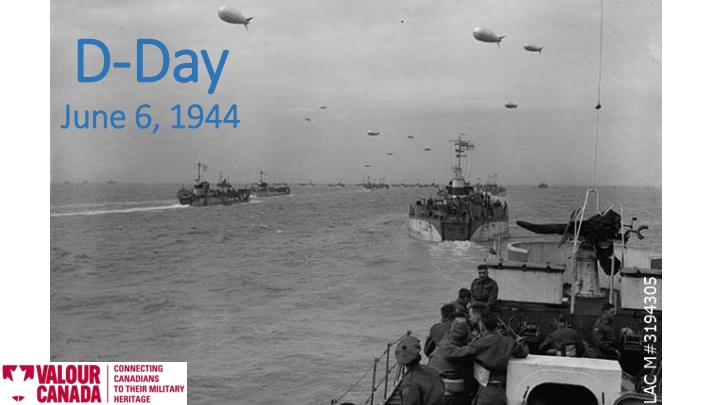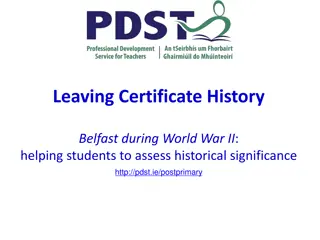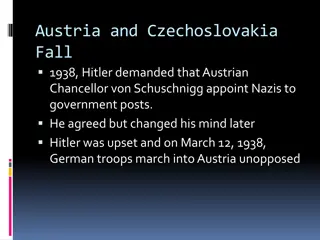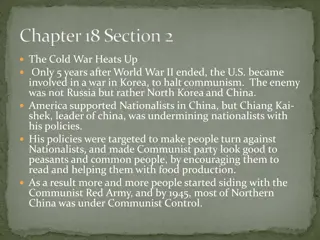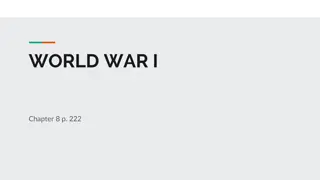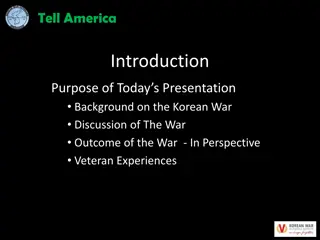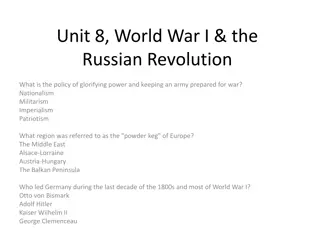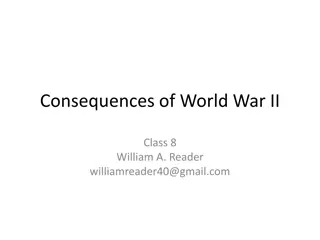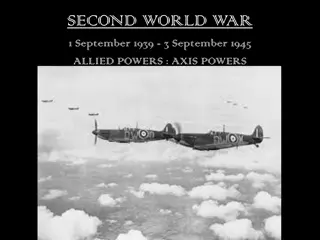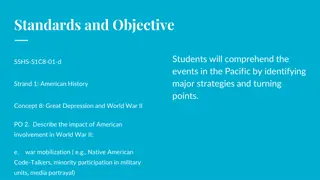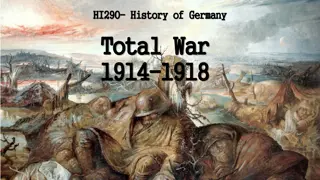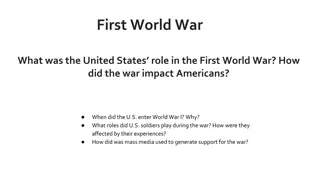World War 2 Key Events and Operations
World War 2, spanning from 1939 to 1945, saw significant events like the invasion of Poland, Operation Barbarossa, D-Day landings, and the conclusion with V-E and V-J Days. Operations such as Dieppe (Operation Jubilee) in 1942 taught crucial lessons in military strategy and coordination. The Atlantic Wall and Nazi dominance were pivotal aspects of the war, leading to the liberation of Auschwitz and the use of atomic bombs on Hiroshima and Nagasaki.
Download Presentation

Please find below an Image/Link to download the presentation.
The content on the website is provided AS IS for your information and personal use only. It may not be sold, licensed, or shared on other websites without obtaining consent from the author.If you encounter any issues during the download, it is possible that the publisher has removed the file from their server.
You are allowed to download the files provided on this website for personal or commercial use, subject to the condition that they are used lawfully. All files are the property of their respective owners.
The content on the website is provided AS IS for your information and personal use only. It may not be sold, licensed, or shared on other websites without obtaining consent from the author.
E N D
Presentation Transcript
D D- -Day Day June 6, 1944 June 6, 1944
World War 2: 1939 World War 2: 1939 42 Key Events 42 Key Events 1939 - Germany invades Poland and Phoney war begins (Sep.) 1940 - Blitzkrieg ( lightning war ) Holland, Belgium, France surrenders - Dunkirk evacuation (May/June); Battle of Britain (July - Oct) 1941- Germany invades U.S.S.R. (Barbarossa) to take Moscow, but a hard winter stymies further German advance - Hitler begins strengthening coastal defenses in France - a lot of fighting in countries surrounding the Mediterranean - Japan on the rise; Pearl Harbour; U.S. enters the war - the war turns global (Pacific Ocean); Battle of Hong Kong 1942 - U.S.S.R. stops Germany; Holocaust s Final Solution initiated
N Nazi azi Dominance Dominance The Atlantic Wall
World War 2: 1942 World War 2: 1942 45 Key Events 45 Key Events 1942 - (cont d) Dieppe;Battle of the St. Lawrence 1943 - U.S.S.R. pushes back and retakes many of its cities - Operation Husky (Allies invade Sicily) 1944 - Allies land at Anzio, Italy; Soviets continue westward - Normandy Invasion (D-Day), then Battle of the Bulge 1945 - Allies and Soviets are rolling; Auschwitz liberated by U.S.S.R. - Soviets win race to Berlin; Hitler commits suicide - MAY 8th= V-E Day (E=Europe) - U.S.A. A -Bombs: Hiroshima (Aug 6th) and Nagasaki (Aug 9th) - AUG 15th= V-J Day (J=Japan) War Ends
Dieppe Dieppe, , Operation Jubilee, 1942 August Objective: To seize, hold, destroy an enemy-held port. - Gain intelligence - Morale Why?
Dieppe Dieppe: : Operation Jubilee, 1942 August Result: 6000 soldiers (5000 are Canadian) repelled 60% killed, wounded, or captured Inspecting the Dieppe defences months after D-Day Lessons Learned: - Surprise and secrecy (and deception) - Planning and preparation - Casualties inevitable on beach (need speed) - Solid ground required to land machinery - Coordination between air, sea, ground - Harbours will be sabotaged by the enemy - Seize key bridges inland at same time - - REMEMBER THESE LESSONS! - -
G German erman Defences: Fortress Europe and the Atlantic Wall Defences: Fortress Europe and the Atlantic Wall
G German erman Defences: Fortress Europe and the Atlantic Wall Defences: Fortress Europe and the Atlantic Wall Machine-gun Emplacement (Normandy, beach unknown) Cliffside Emplacement (Normandy, beach unknown)
G German erman Defences: Fortress Europe and the Atlantic Wall Defences: Fortress Europe and the Atlantic Wall Merville Battery (near Sword Beach) Modern view 31 March 1944 Reconnaissance Photo
G German erman Defences: Fortress Europe and the Atlantic Wall Defences: Fortress Europe and the Atlantic Wall Longues-sur-Mer Battery Command + Ranging Post (near Gold and Omaha Beaches)
D D- -Day Day (6 June 1944): (6 June 1944): Operations OVERLORD and NEPTUNE Operations OVERLORD and NEPTUNE Canadians coming ashore at Juno Beach after the coast has been secured. LAC M#3205311
Invasion on D Invasion on D- -Day: Two Intertwined Operations Day: Two Intertwined Operations 1- Operation OVERLORD 1944 Jun. GOAL: To successfully land soldiers and equipment in German-held France so that a western front is opened versus the Wehrmacht (take and hold to the Seine River). -- OVERLORD is the all-inclusive plan --
Invasion on D Invasion on D- -Day: Two Intertwined Operations Day: Two Intertwined Operations 2- Operation NEPTUNE This is the coastal assault by the Allies. NEPTUNE is the water portion of OVERLORD. GOAL: To land 130,000 soldiers, 30,000 vehicles/ artillery (from England) on the French coast Activity: Decide where to land and how to do it.
Operation NEPTUNE/OVERLORD: Operation NEPTUNE/OVERLORD: Where will you land Where will you land? ? At your disposal: - 300,000 British, American, and Canadian army soldiers (Recall Dieppe = 6,000) - 4,000 aircraft (including all necessary pilots, crew, etc.) - 10,000 ships/watercraft (including all necessary sailors, support staff, etc.) - a finely-tuned industry that can create almost anything for your Armed Forces
Operation NEPTUNE/OVERLORD: Operation NEPTUNE/OVERLORD: Where will you land Some points to consider when choosing where to invade: - Weather and sea tides - Remember: you need to land at low tide. - Aspect - Will your soldiers be looking into the sun as they move forward? - Moon phase - Do you intend to perform any night operations? - German defences- On land? Their airspace control? Control of the sea? - Your equipment requirements and availability. - Can you trick/deceive them into thinking something incorrect? Where will you land? ? These are only some of the things the D-Day planners needed to account for. Directions: With your group Review YOUR MISSION and answer Q s # 1-5. Make sure to record your reasoning on the Worksheet. Be prepared to explain your group s answers and reasoning to the class.
Activity # 1: Where will you land? Activity # 1: Where will you land? HINTS- When choosing a location, think about these factors: - Distance from your ports in England (travel and resupply distance) - Enemy defences and distance from their reinforcements - Access to travel infrastructure after landing (i.e. roads, railways, etc.) - Where does the enemy think an invasion is most likely? (think of the previous 4 pts) - It is possible, but dangerous, to travel through Naval minefields (green)
Solutions: Activity # 1 (the Warmup) Solutions: Activity # 1 (the Warmup) Q # 1- Why were the soldiers, equipment, etc. spread throughout England? - Reduce potential for major loss if one collection is bombed. - Reduce potential that the enemy would think that a major action (attack/invasion) was coming. Q # 2- Should you use all your resources or keep some in reserve? - Almost always a good idea to have some in reserve. Why? Often unpredictable things happen. Also, England should keep some behind in case they re attacked. Q # 3- How will the soldiers and equipment get across the beach? Difficulties faced? - On foot. Very few are in tanks. Some arrive after the initial assault in wheeled vehicles. - Facing heavy fire with almost zero cover. Many obstacles, mines, etc. If sand is soft, vehicles can get stuck. Q # 4- Invasion Time of Day? Why? - 06:30 08:00 (early morning) - Darkness during preparatory movements and travel across English Channel. - Light upon arrival allows everyone to see obstacles and routes of attack.
Q # 5 Solution: The Normandy area of France Q # 5 Solution: The Normandy area of France # 4 # 4
Why Normandy? The Commanders and Planners thought it was a favourable location because: - not an obvious location to the enemy - beaches have low topography - sand compaction will hold tanks - many options for expansion after landing - big enough area to land a lot at once = multiple simultaneous threats to enemy - 2 deep water ports in play (Cherbourg and Le Havre) - Bay of Normandy shelters assaulting boats from winds - within flying range of fighter planes - easier to resupply from west if taken (Atlantic Ocean- the U.S.)
O Operation Neptune: Activity # 2 (the Real Deal) peration Neptune: Activity # 2 (the Real Deal) How do you move across the English Channel and land the soldiers and equipment (get a foothold on Europe) successfully? Your group is going to get the opportunity to come up with a plan . . . On the double soldiers!
Activity # 2: Create an Invasion Plan Activity # 2: Create an Invasion Plan Part 1 and 2: Read the instructions beneath YOUR MISSION Part 1- TASKS: - 1 scorekeeper - 1 writer - 1 timekeeper (3 min per card, 6 cards) TIMING: 18 min to complete all 6 cards 5 min to summarize Part 2- GOING DEEPER: TIMING: 5 min for each question Scorekeeper: After activity, each scorekeeper moves to the adjacent group to track their score.
Activity # 2: Create an Invasion Plan for Normandy Activity # 2: Create an Invasion Plan for Normandy
Solutions: Activity # 2 (the Real Deal) Solutions: Activity # 2 (the Real Deal) Allied Air Power: - Bombing airfields, plane factories, reserve units easier to acquire air superiority - Bombing enemy defences to weaken enemy, but needs to be done carefully - Reconnaissance (Scouting) of defences accurate maps, plans, anticipate enemy actions - Insertion of airborne soldiers inland to take/hold bridges for road/rail/canal control - Patrol during assault to maintain air control over the beaches Allied Warships: - Pound coastal defenses, particularly gun emplacements reduce firepower directed at assault - Clear the English Channel of boats/planes to reduce risk to invasion fleet - Escort valuable cargo across the Channel reduce risk to invasion fleet Haida on D-Day: Vice Admiral Harry DeWolf, Halifax, NS
Solutions: Activity # 2 (the Real Deal) Solutions: Activity # 2 (the Real Deal) Allied Minesweepers: - Clear the Channel of any naval mines reduce risk to invasion fleet and shorten route for fleet 3rd Canadian Infantry Division soldiers landing at Berni res in the Juno Beach sector Caraquet on D-Day: Rear Admiral Anthony Storrs of Victoria, BC Allied Assault/Landing Craft: - Take soldiers, vehicles, equipment to the beach protected from enemy for as long as possible
Solutions: Activity # 2 (the Real Deal) Solutions: Activity # 2 (the Real Deal) Allied Intelligence Operations: Four Goals: 1) Create diversions to focus attention away from Normandy 2) Provide cover protect real airborne soldiers 3) Delay enemy reinforcements (see # 1, 2, 3) 4) Confuse enemy radar (see # 1) How? Using visual cues, sounds, fake communications, spies + double agents - Operation FORTITUDE North (Norway) and FORTITUDE South (Calais) Alongside NEPTUNE were: Operations TAXABLE, GLIMMER, MANDREL, TITANIC
Summary of your Invasion Plan: Summary of your Invasion Plan: Generally speaking, First, you ll use your Intelligence Operations to deceive Second, you ll use your Air Power to weaken the enemy . . . D-Day, 6 June 1944 arrives . . . Third, your Minesweepers will clear a path across the Channel Fourth, your fleet will leave for Normandy with your Warships on the lookout (and will fire on coastal defences once within range) Fifth, your Assault/Landing Craft will move to the beaches
Debrief: Operation OVERLORD Debrief: Operation OVERLORD AND AND NEPTUNE NEPTUNE Thinking about D-Day and the challenges faced by the Allies, which of the 6 character traits do you feel were most important for their success? Are they the same as those needed by your group to complete this exercise successfully? Do you think that modern communications (texting, email, etc.) would make D-Day planning and coordination easier or more difficult? Why? Which parts of the activity had the biggest impact on you and why? Deluxe Shelter
Skip to final 2 slides, if inadequate time for Going Deeper Q #1 and 2
GOING DEEPER GOING DEEPER Q # 1 How do you suggest the attacking/invading boats should depart their English ports and then move across the Channel to Normandy? 1. Minesweepers prepare 10 channels the night before. 2. Five task groups, 1 per beach, leave to meet at Piccadilly Circus in the early morning. Utah Force departs first. Discussion . . . Ideas? 3. Task groups pour through the spout (cleared channels), timed to exit slightly after dawn. (At dawn, naval barrage begins targeting coastal strongpoints)
GOING DEEPER GOING DEEPER Q # 2 Thinking about your finely-tuned industry , if you could build something helpful for your invasion, what would it be? Mulberry A + B Harbours: - A at Omaha, B at Gold - constructed piers - Sections are floated to Normandy, assembled, and used to offload equipment and supplies - B used for 5 months, landed 2,000,000 soldiers, 500,000 vehicles, 4,000,000 tons of supplies Discussion . . . Ideas?
Operation Overlord: The Result, The Cost Operation Overlord: The Result, The Cost -- April + May, Air Forces: 12,000 casualties and 2,000 aircraft -- On D-Day (1 day): 10,000 Allied soldier casualties (4000-4500 deaths) ??? German soldier casualties (estimated as similar) -- June naval losses: 60 ships, 120 others damaged --
Operation OVERLORD Operation OVERLORD: : 6 June to 30 August, 1944 (Normandy to Seine R. = 86 days) 209,000 Allied, 216,000 Axis casualties 15,000 civilian deaths As the next year progressed, the Wehrmacht (German Armed Forces) would be pushed back into Germany by the US/Britain/Canada in the west and the Soviets in the east. 11 months after D-Day: V-E Day (May 8, 1945: Victory Europe Day) Then on August 15, days after Little Boy (Hiroshima) and Fat Man (Nagasaki), V-J Day (Victory Japan Day) The Second World War has ended.
